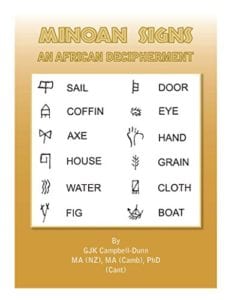
Shelf Unbound: You’ve written several books on Indo-European and Niger-Congo languages. What interested you in these topics?
Graham Dunn: My mother believed in the value of Latin, teaching me the names of the plants in that language at a young age. My father started me on the piano and I encountered musical words in Italian. At school I was instructed in Latin by the Catholic priests who also taught me phonetics.
The professor of Classics at university advised me to take Greek, and recommended learning French and German. He introduced me to Mycenaean, which was written in a pictographic script known as Linear B, clearly not designed for Indo-European but for some exotic language. After a period of study at Cambridge I returned to New Zealand and married an Italian. She brought with her a grammar of Swahili and introduced me to African languages.
Shelf Unbound: How do you go about researching language origins?
Dunn: Identifying the language of Linear A began with a comparison between Bantu language names and Minoan words. Homeric (W)ANAX had Congolese cognates, typically WANA “child.” The Homeric “sacred king” had once been an African “child king.” Analysis of Minoan KURO “big total” and KIRO “small total” in terms of Bantu revealed KU “big” and KI “small” were prefixes preceding the monosyllabic root RO “total.”
Shelf Unbound: Can you in layman’s terms explain the significance of Fula and Gola?
Dunn: Fula and Gola (also called Gura) are Atlantic languages, belonging to the western branch of Niger-Congo. Major Nigerian dialects of Fula are centred on Kano, Sokoto, and Adamawa. Gola, unlike Fula, retains the labiovelars, eg. GWE “sun,” which exist in Minoan.
Not only Minoan, but all Indo-European languages derive from the Atlantic subgroup, particularly the subsubgroup of Fula, Gola, Bulom, Limba etc. This has serious implications for the classification of Indo-European and Niger-Congo. It is also relevant to laryngeal theory.
Shelf Unbound: What are you wanting readers to take away from your books?
Dunn: Minoan and Greek must be re-evaluated in an African context. Problematic Classical Greek words can now be etymologised. Minoan Linear A has now been deciphered as a language close to Fula. Minoan civilisation is animistic and derives from Africa. Minoan and ancient Greek practices are clarified and made more intelligible by African comparisons.
